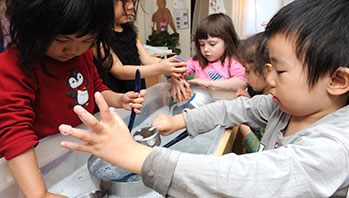- four large tubs or water tables
- funnels
- pipettes or eyedroppers
- plastic cups
- soda bottles
- sponges
- squirt bottles
- toy water pumps or recycled soap dispensers
- turkey basters, water
- baster
- flow
- pour
- pump
- squirt
MA Standards:
Language/L.PK.MA.6: Use words and phrases acquired through conversations, listening to books read aloud, activities, and play.
MA Draft STE Standards:
Earth and Space Sciences/Earth’s Systems/ESS2.A: Observe, investigate, and classify the non-living materials, natural and human made, in their environment.
Physical Sciences/Matter and Its Interactions: Structure and Properties of Matter/PS1.A: Describe, compare, sort and classify objects based on observable physical characteristics, uses, and whether it is manufactured as part of their classroom play and investigations of the natural and human-made world.
Head Start Outcomes:
Logic and Reasoning/Reasoning and Problem Solving: Classifies, compares, and contrasts objects, events, and experiences.
Science Knowledge/Conceptual Knowledge of Natural and Physical Worlds: Observes, describes, and discusses properties of materials and transformation of substances.
PreK Learning Guidelines:
English Language Arts/Language 2: Participate actively in discussions, listen to the ideas of others, and ask and answer relevant questions.
Science and Technology/Earth and Space Sciences 5: Compare and contrast natural materials such as water, rocks, soil, and living organisms using descriptive language.
Science and Technology/Physical Sciences 19: Explore, describe, and compare the properties of liquids and solids found in children's daily environment.
Explore Together (indoors): Pour, Squirt, & Pump

© Commonwealth of Massachusetts, Department of Early Education and Care (Jennifer Waddell photographer). All rights reserved.
STEM Key Concepts: You can use different objects to move water
ELA Focus Skills: Listening and Speaking, Vocabulary
Educator Prep: For this activity, set up four areas of the room for children to explore. Cover the floor with plastic. Put newspapers or towels on top.
- Place four water tables or tubs of water in different areas of your room.
- Place funnels by one tub or water table; place plastic cups, bottles and other containers by another tub or water table; place turkey basters and water pumps by a third tub or water table.
- Provide water smocks (garbage bags with holes for head and arms work well).
Safety Tips:
- Be sure to clean and disinfect the water table and the plastic containers daily and fill the table with fresh water each day.
- Be sure to have plenty of towels and/or a mop handy for clean-up of spills.
Have children continue to explore moving water with the tools, but this time include more complex tools: a turkey baster and a water pump.
Divide children into four groups this time: one to explore moving water with their hands, one to explore moving water with the plastic cups and bottles, another group to explore moving water with the funnels, and the last group to explore moving water with the turkey basters and water pumps. Ask,
- How far can you squirt the water using the tools?
- Can you use the tools to make bubbles in the water? Different sounds?
Have children continue exploring before they switch stations, encourage them to show you one way to use the tool they are currently using.
Reflect and Share
Have children share their observations. Ask,
- What did you see and hear using the tools today?
- What did you see the water do?
- How did it move, or flow?
Have children demonstrate any discoveries.
Adaptation: If the weather is warm, wheel your water tables outside or fill a plastic pool with water. Then help children do the activities outdoors, where they can explore without worrying about spills.
Educator Tip: The activities can take place at the same time in different parts of your room. Since they explore different aspects of water, each one might appeal to a different group of children. Limit the number of children at each water station. Children will want to try all stations, so be sure to allot enough time for children to circulate through all three areas.
Educator Tip: Younger children may need help using the baster. Show them how to submerge the tip of the baster under water before squeezing and releasing the bulb to fill it. Help them practice doing this a few times to help them develop their fine motor skills.
